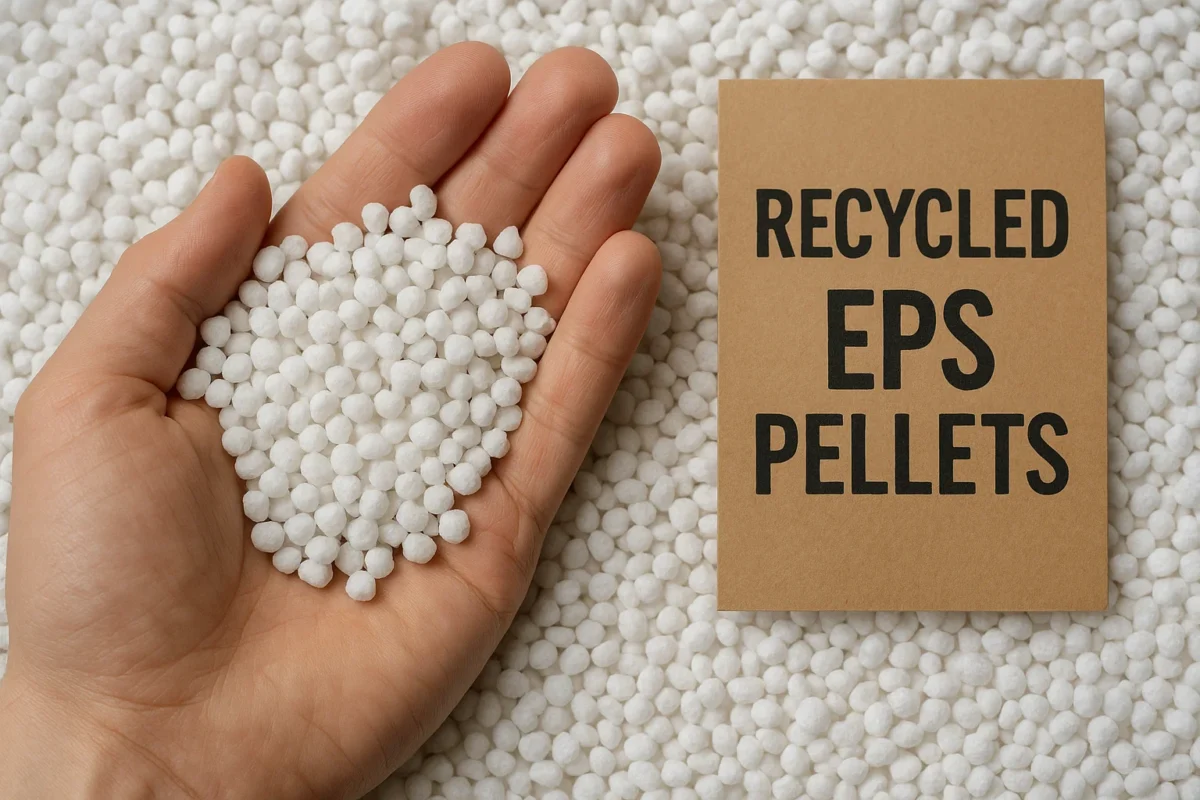Expanded Polystyrene (EPS), commonly known as Styrofoam, is everywhere—from protective packaging to building insulation. But its bulky, lightweight nature makes it a major contributor to landfill waste. What if we could transform this challenge into an opportunity?
Introducing Recycled EPS (rEPS) pellets: a high-quality, sustainable material that offers all the benefits of virgin EPS with a fraction of the environmental impact. By harnessing advanced recycling technology, we can turn cumbersome foam waste into a valuable resource for a new generation of products.
From Bulky Foam to Dense Pellets: The EPS Recycling Journey
Recycling EPS is a unique process, primarily focused on removing the air (which makes up 98% of its volume!) and densifying the material. This transformation is key to making EPS recycling efficient and economical.
- Sourcing and Collection: The process begins with collecting post-consumer and post-industrial EPS waste, such as packaging blocks, insulation sheets, and fish boxes.
- Sorting and Cleaning: The material is sorted to remove tape, labels, and other contaminants. Since EPS is often clean, this step is typically straightforward.
- Densification (The Key Step): The bulky foam is fed into a specialized machine called a densifier or compactor. This machine uses thermal or cold compression to melt or press the foam, removing the air and creating dense, solid ingots or blocks. This reduces the volume by up to 90:1, making it easy to store and transport.
- Grinding and Pelletizing: The densified EPS blocks are then crushed and ground into fine particles. These particles are melted, extruded, and cut into small, consistent rEPS pellets.
- Quality Control: Each batch of rEPS pellets is tested for purity, density, and consistency to ensure it meets high performance standards for manufacturing.
Key Benefits: Why Choose Recycled EPS?
Opting for rEPS pellets provides a powerful combination of environmental, performance, and economic advantages that modern businesses can’t ignore.
- Massive Environmental Impact: Drastically reduces the volume of plastic waste in landfills. Recycling EPS requires significantly less energy than producing it from raw materials, lowering your carbon footprint.
- Exceptional Performance Properties:
- Lightweight: Perfect for creating lightweight concrete, fillers, and products where weight reduction is crucial.
- Superior Thermal Insulation: Retains the excellent insulating properties of virgin EPS, making it ideal for construction materials.
- Durable & Moisture-Resistant: Offers great compressive strength and resists moisture, ensuring long-lasting performance.
- Smart Economics: rEPS is a cost-effective alternative to virgin polystyrene. The densification process also dramatically lowers waste storage and transportation costs for businesses.
- Supports the Circular Economy: Choosing rEPS closes the loop on polystyrene waste, turning a single-use product into a durable, reusable material.
Versatile Applications: Where Can You Use rEPS?
The unique properties of recycled EPS make it an incredibly versatile material for a variety of innovative applications:
- Construction and Building: Used as a lightweight aggregate in concrete, insulation boards, and geofoam blocks for civil engineering projects.
- Protective Packaging: Molded into new, durable packaging materials and corner protectors.
- Furniture and Decor: Used to create picture frames, decorative moldings, and hangers.
- Consumer Goods: A key component in items like surfboards, plant pots, and outdoor furniture.
Frequently Asked Questions (FAQ)
1. What exactly are recycled EPS pellets?
Recycled EPS (rEPS) pellets are small, durable granules made from densified Expanded Polystyrene (EPS) foam waste. This process removes the air from bulky Styrofoam products, turning them into a solid, reusable raw material for new manufacturing.
2. Is recycled EPS waterproof and a good insulator?
Yes. Recycled EPS retains the closed-cell structure of virgin polystyrene, which makes it highly resistant to moisture and an excellent thermal insulator. These properties make it a trusted material for construction and cold-chain packaging applications where temperature control and moisture protection are vital.
3. What are the primary uses for rEPS pellets?
The most common applications leverage its lightweight and insulating properties. These include lightweight concrete, building insulation, new packaging materials, and decorative moldings. It is also used as a lightweight filler in a variety of composite materials.
4. How is bulky Styrofoam recycled into dense pellets?
The key is a machine called a densifier. It uses heat or pressure to melt and compact the foam, removing the vast amount of air it contains. This creates dense, manageable blocks that are then ground down and reformed into pellets, making the material efficient to transport and reuse.
Ready to make a lightweight choice for a heavy impact?
Choose Recycled EPS Pellets for your next project and lead the way in sustainable innovation. Contact Us Today to learn more about our rEPS products or the densifying machinery that makes it all possible!

